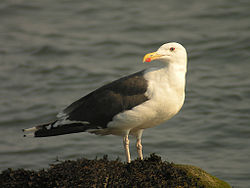
Great Black-backed Gull
Did you know...
This wikipedia selection has been chosen by volunteers helping SOS Children from Wikipedia for this Wikipedia Selection for schools. A good way to help other children is by sponsoring a child
| Great Black-backed Gull | |
|---|---|
 |
|
| Conservation status | |
|
Least Concern
|
|
| Scientific classification | |
| Kingdom: | Animalia |
| Phylum: | Chordata |
| Class: | Aves |
| Order: | Charadriiformes |
| Family: | Laridae |
| Genus: | Larus |
| Species: | L. marinus |
| Binomial name | |
| Larus marinus Linnaeus, 1758, Gotland, Sweden |
|
 |
|
| Distribution across the Northern Hemisphere | |
The Great Black-backed Gull, Larus marinus, is a very large gull which breeds on the European and North American coasts and islands of the North Atlantic. It is fairly sedentary, but some Great Black-backed Gulls move further south or inland to large lakes or reservoirs.
The Great Black-backed Gull was one of the many species originally described by Linnaeus in his 18th century work, Systema Naturae, and it still bears its original name of Larus marinus.
This is the largest gull, much bigger than a Herring Gull and is often described as the King of Gulls. It is 61-74 cm (24-28 in) long with a 1.4-1.7 m wingspan, the large adult males often weighing in at more than 2 kilogrammes. It is bulky, and has a powerful bill. The adults have black wings and back, with conspicuous white "mirrors" at the wing tips. The legs are pinkish, and the bill yellow with a red spot.
Young birds have scaly black-brown upperparts, and a neat wing pattern. They take at least four years to reach maturity, development in this species being somewhat slower than that of other large gulls. The call is a deep "laughing" cry.
Unlike most Larus gulls, Great Black-backed Gulls are mostly carnivorous and frequently hunt and kill any prey smaller than themselves, behaving more like a raptor than a typical larid gull, though they will also scavenge. They frequently rob other seabirds of their catch. They can swallow a puffin or a small wild duck whole.
This species breeds singly or in small colonies, making a lined nest on the ground often on top of a rocky stack. 3-5 eggs are laid.
